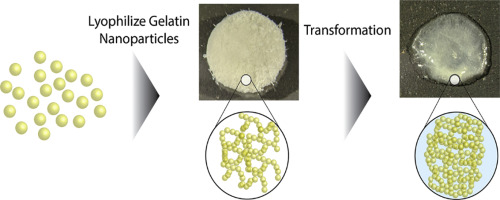当前位置:
X-MOL 学术
›
J. Control. Release
›
论文详情
Our official English website, www.x-mol.net, welcomes your
feedback! (Note: you will need to create a separate account there.)
Development of hydrogel-like biomaterials via nanoparticle assembly and solid-hydrogel transformation.
Journal of Controlled Release ( IF 10.5 ) Pub Date : 2019-12-16 , DOI: 10.1016/j.jconrel.2019.12.026 James Coyne 1 , Nan Zhao 1 , Anuoluwapo Olubode 1 , Mridula Menon 1 , Yong Wang 1
Journal of Controlled Release ( IF 10.5 ) Pub Date : 2019-12-16 , DOI: 10.1016/j.jconrel.2019.12.026 James Coyne 1 , Nan Zhao 1 , Anuoluwapo Olubode 1 , Mridula Menon 1 , Yong Wang 1
Affiliation

|
Hydrogels for biomedical applications such as controlled drug release are usually synthesized with the chemical or physical crosslinking of monomers or macromers. In this work, we used gelatin to prepare hydrogel nanoparticles and studied whether gelatin nanoparticles (GNPs) could assemble to form a solid biomaterial and whether this solid biomaterial was capable of transforming into a hydrogel upon introduction to a hydrated environment. The data show that GNPs with or without aptamer functionalization could form a nanoparticle-assembled porous solid biomaterial after freezing and lyophilization treatment. This formation did not need any additional crosslinking reactions. More importantly, this solid biomaterial could undergo solid-to-hydrogel transition after contacting a solution and this transformation was tunable to match different shapes and geometries of defined molds. The formed hydrogel could also sequester and release growth factors for the promotion of skin wound healing. Thus, GNP-assembled solid biomaterials hold great potential as an off-the-shelf therapy for biomedical application such as drug delivery and regenerative medicine.
中文翻译:

通过纳米粒子组装和固-水凝胶转化开发类似水凝胶的生物材料。
通常在单体或大分子单体的化学或物理交联过程中合成用于生物医学应用(例如控释药物)的水凝胶。在这项工作中,我们使用明胶制备了水凝胶纳米颗粒,并研究了明胶纳米颗粒(GNP)是否可以组装形成固体生物材料,以及这种固体生物材料在引入水合环境后是否能够转化为水凝胶。数据显示,具有或不具有适体功能化的GNP在冷冻和冻干处理后可以形成纳米颗粒组装的多孔固体生物材料。该形成不需要任何额外的交联反应。更重要的是,这种固体生物材料在与溶液接触后可能会经历从固体到水凝胶的转变,这种转变可以调整以匹配定义模具的不同形状和几何形状。形成的水凝胶还可以隔离并释放生长因子,以促进皮肤伤口愈合。因此,由GNP组装的固体生物材料具有巨大的潜力,可以作为药物输送和再生医学等生物医学应用的现成疗法。
更新日期:2019-12-17
中文翻译:

通过纳米粒子组装和固-水凝胶转化开发类似水凝胶的生物材料。
通常在单体或大分子单体的化学或物理交联过程中合成用于生物医学应用(例如控释药物)的水凝胶。在这项工作中,我们使用明胶制备了水凝胶纳米颗粒,并研究了明胶纳米颗粒(GNP)是否可以组装形成固体生物材料,以及这种固体生物材料在引入水合环境后是否能够转化为水凝胶。数据显示,具有或不具有适体功能化的GNP在冷冻和冻干处理后可以形成纳米颗粒组装的多孔固体生物材料。该形成不需要任何额外的交联反应。更重要的是,这种固体生物材料在与溶液接触后可能会经历从固体到水凝胶的转变,这种转变可以调整以匹配定义模具的不同形状和几何形状。形成的水凝胶还可以隔离并释放生长因子,以促进皮肤伤口愈合。因此,由GNP组装的固体生物材料具有巨大的潜力,可以作为药物输送和再生医学等生物医学应用的现成疗法。











































 京公网安备 11010802027423号
京公网安备 11010802027423号